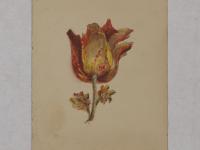This lesson focuses on primary sources from women's botanical textbooks from the early 1800's. Teaching science and literacy today, through the use of these old texts, allows students to think critically about their own studies while comparing and contrasting their work to the primary source text. This method also includes a hands-on approach to looking at history, science, and language arts as students will create herbaria similar to those created by the women at the emerging female academics as well as read and recreate nineteenth century poetry. Learning the parts of a plant and poetry are important classroom topics, therefore, by acknowledging the similarities and differences between textbooks written in the 1800's and texbooks today, students will convey a deeper understanding of the subject matter and connect their learning to the broader context of history.
The primary sources used in this lesson are from textbooks written by Almira Lincoln Phelps and used at multiple female academies, including Troy Female Seminary. The primary sources explain how to create your own herbarium as well as how to identify the different parts of a flower in nineteenth century terms. Student will have an unique experience by combining, literacy, history, and science to complete this lesson. They are expected to compare and contrast the nineteenth century textbook to their own studies of plant classification and poetry. The end result will be the creation of a herbarium and poetry book similar to those created by women in the 1800s.


